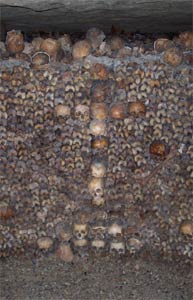
The Catacombs of Paris are a network of tunnels and caves that run for more than 300 kilometers under the city. To build a city, you need materials. The Romans were the first to quarry the limestone in the area in 60 B.C.E.; however, those quarries were the open-air kind -- the Romans just dug out the rock that was exposed. As the city grew and covered the landscape, tunneling would be required to get more building materials. In 1180 C.E., Philippe-Auguste became King. He was a major proponent of tunneling to quarry in order to build ramparts to protect the city, and it was under his rule that this tunnel network would truly be born.The quarries grew in size and complexity and produced building materials for centuries to come. Quarrying continued with reckless abandon until problems began to arise. In the eighteenth century, the city of Paris (and the weight of its buildings) continued to grow as the ground became more hollow underneath. Some buildings began to collapse and fall into the earth that was opening up below them. On April 4, 1777, the Inspection Générale des Carrières was formed to manage, fill in, or close sections of the tunnels deemed dangerous.It was during the eighteenth century that a second problem arose for Parisians -- the graveyards were getting full... very full. The Cimetière des Innocents (Cemetery of the Innocent) alone held more than thirty generations of human remains. Taara, as she is known in the Paris underground, is the author of a Web site on the Catacombs. She said, "Families used to pay the parish priest to bury their dead in
 here [the cemetery near the church]. The priest didn't want to refuse money, so after a while, of course, there's no more place [to put the bodies]. So many priests decided to build a sort of house for dead people, which is called a 'charnier' [mass grave]. The dead accumulated there."As the emerging city enclosed around the cemeteries, there was no place to go but up. Near the end of the life of the Cemetery of the Innocent, as well as several other cemeteries, the ground swelled more than ten feet above the road. The smell was tormenting those who lived in close proximity to the graveyard. Some of the cemetery walls actually broke open, spilling rotting bodies onto the street. Soon after, disease took hold of those living in the vicinity, and people began dying from the pestilence spread by the corpses.The decision was made to start emptying the cemetery and to place the bones into the network of tunnels under the city. In 1785, when the bones were moved to the underground network en masse, the quarries became the Catacombs. The first quarry that received the bones is called 'Carrière de la Tombe Issoire.' Disturbing the dead is a bit of a universal taboo. It's understood across many cultures that one should leave the dead alone, and many go through great care to perform rituals and ceremonies to see their departed loved ones off to the afterlife. However, the living will usually take precedence.
here [the cemetery near the church]. The priest didn't want to refuse money, so after a while, of course, there's no more place [to put the bodies]. So many priests decided to build a sort of house for dead people, which is called a 'charnier' [mass grave]. The dead accumulated there."As the emerging city enclosed around the cemeteries, there was no place to go but up. Near the end of the life of the Cemetery of the Innocent, as well as several other cemeteries, the ground swelled more than ten feet above the road. The smell was tormenting those who lived in close proximity to the graveyard. Some of the cemetery walls actually broke open, spilling rotting bodies onto the street. Soon after, disease took hold of those living in the vicinity, and people began dying from the pestilence spread by the corpses.The decision was made to start emptying the cemetery and to place the bones into the network of tunnels under the city. In 1785, when the bones were moved to the underground network en masse, the quarries became the Catacombs. The first quarry that received the bones is called 'Carrière de la Tombe Issoire.' Disturbing the dead is a bit of a universal taboo. It's understood across many cultures that one should leave the dead alone, and many go through great care to perform rituals and ceremonies to see their departed loved ones off to the afterlife. However, the living will usually take precedence.
No comments:
Post a Comment